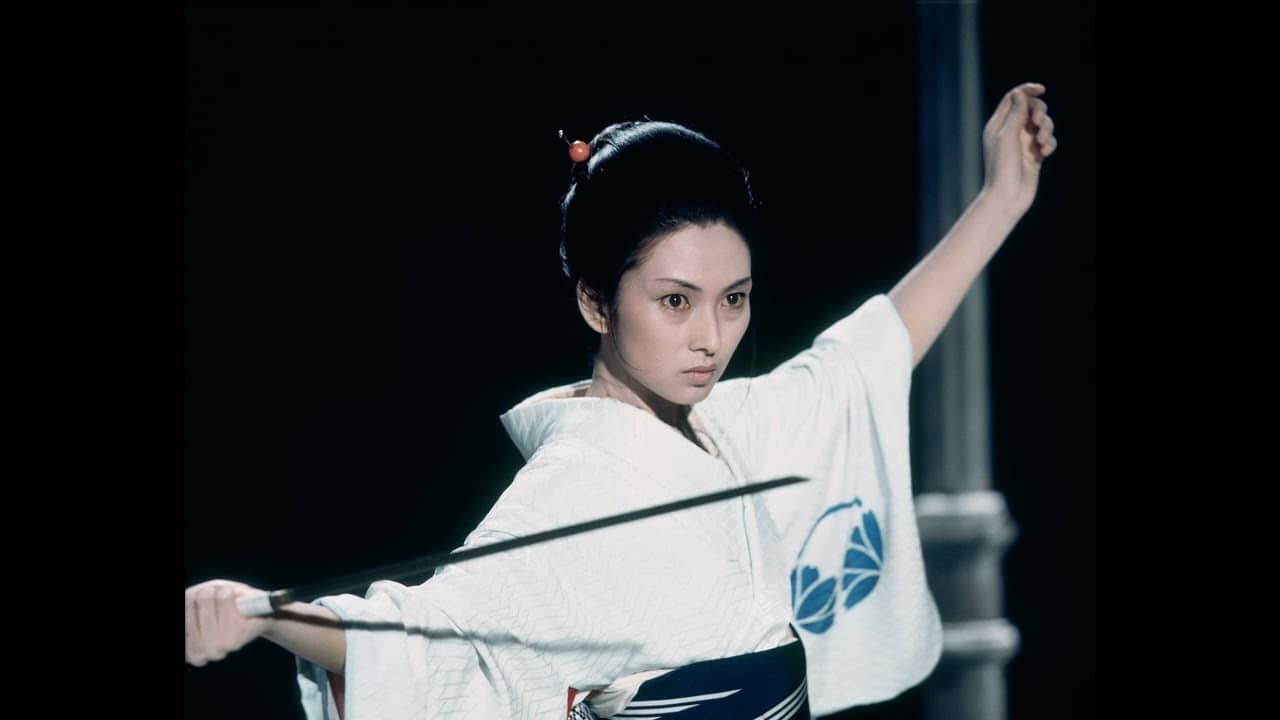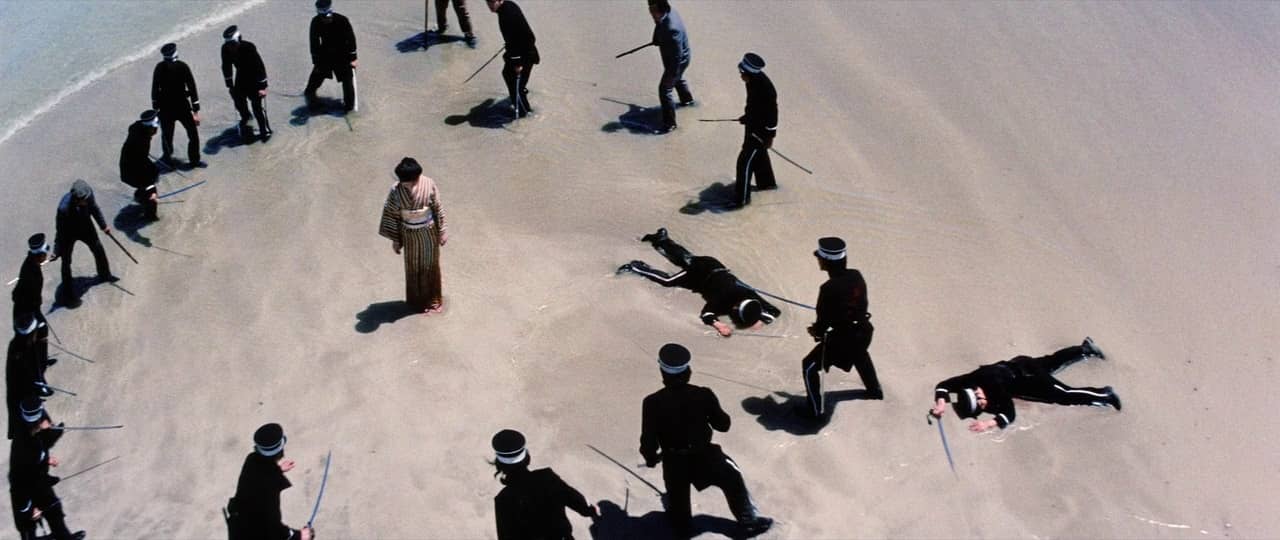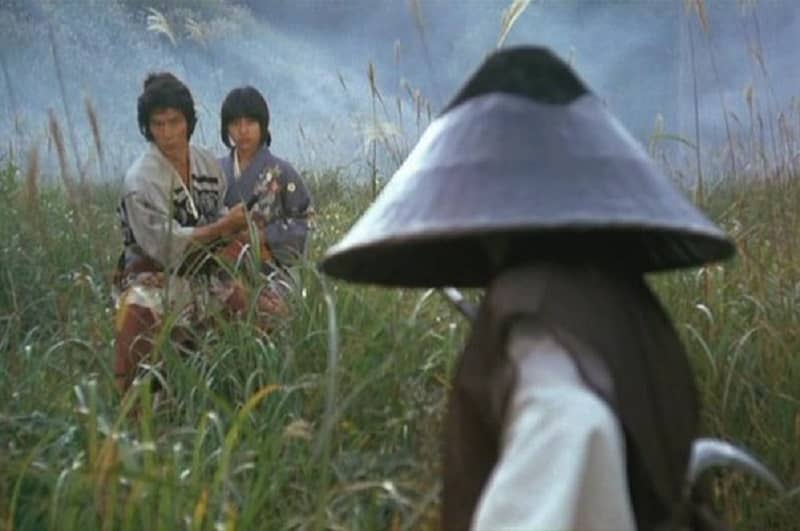Ellsworth’s Cinema of Swords: Weird Samurai
Lady Snowblood (Japan, 1973)
Japanese chanbara (samurai swordplay) adventure shows and movies had a long history of being adapted from popular manga series. As the Sixties turned into the Seventies, chanbara manga got increasingly bizarre and extreme, and the screen adaptations followed. These historical fantasies drew on the avant-garde film movements of the last Sixties, but also pulled imagery and characters from traditional sources, melding dream-logic with ghostly revenants. Bracing stuff, and if it’s sometimes hard to follow their abrupt 90-degree turns, the stories always sort themselves out in the end.
Lady Snowblood
Rating: ***
Origin: Japan, 1973
Director: Toshiya Fujita
Source: Criterion DVD
This bloody revenge drama was one of the primary inspirations for Quentin Tarantino’s Kill Bill, and it’s easy to see why, as it’s equal parts artistic and cheesy. Yuki, or Lady Snowblood (Meiko Kaji), is born in Tokyo Prison in 1874 where her mother, Sayo, was imprisoned for killing one of the men who’d raped her and killed her husband and son. Dying, Sayo bequeaths to her newborn daughter the mission of slaying the three other criminals who got away, committing Yuki and her mission to another prisoner, Tajire (Akemi Negishi), who takes the girl to be trained in martial arts by a fierce ex-priest with a grudge against the world. Flash forward twenty years as Yuki confronts a Tokyo crime boss and his three sword-armed escorts on a dark street. She seems to carry nothing but an umbrella, but it has a sword blade concealed in its handle, and with that and some astonishing leaps, Yuki kills them all.
Only later do we learn why. The story is told in a series of flashbacks, stylish but not confusing, and after some establishing exposition, it becomes clear that Yuki slew the crime boss because he was an enemy to the ragged Matsuemon (Hitoshi Takagi), leader of an extensive network of beggars, a clan of the unseen who may be able to track down Yuki’s targets for her. Though the ex-priest had tried to make a heartless asura death-demon out of her, Yuki is far from emotionless and is desperate for leads to help her complete her life’s mission. In fact, her life story seems to belong to almost everyone but herself: to her dead mother, whose last words were, “I will die and my spirit will possess her,” to her foster mother Tajire, to the angry ex-priest, and to a muckraking young journalist Yuki meets who seems to know everything about her. Yuki has nothing for herself except her mission of blood, and is increasingly driven to complete it.
The story is adapted from the manga series by Kazuo Koike (writer of Lone Wolf and Cub) and Kazuo Kamimura, which depicts Japan at the end of the 19th century as a society that has descended into greed and rampant corruption, against which Lady Snowblood stands with her purity of purpose, grim though it may be. Despite the film’s low budget and shallow characters, the sharp direction by Toshiya Fujita and the blushing charisma of star Meiko Kaji pull it through. At the climax, during a snowstorm, Yuki tracks her last target to a masked ball in a house of pleasure complete with deranged assassins, revolving secret doors, and one-way mirrors, and you can’t really ask for more than that.
Lady Snowblood: Love Song of Vengeance
Rating: ***
Origin: Japan, 1974
Director: Toshiya Fujita
Source: Criterion DVD
This sequel is even wilder than the first movie. It’s 1906, ten years after the first film, and Yuki (Meiko Kaji) has continued working as Lady Snowblood, assassin for hire. Japan is in the grip of nationalistic and militaristic euphoria following the military defeat of Russia the previous year — all but the poor and the wounded veterans who are jammed into Tokyo’s slums. Yuki is constantly on the run from swordsmen out for revenge for her murders, and from the brutal Tokyo police, who are worse than the swordsmen. A fugitive, she is saved from a bear trap by a mysterious dreamboat doctor, but then is surrounded again by the police, this time on a beach. Sick of fighting, she throws away her sword and surrenders.
Then things take a bizarre turn. Yuki is tried, convicted, and condemned, held in the same Tokyo prison where she was born. But on the way to the gallows, assassins wearing bizarre baby masks slaughter her guards and take her to an ominous estate where she meets Kikui (Shin Kishida, terrifying), the head of the secret police. She is to be freed and allowed to continue her career if she agrees to spy upon the notorious anarchist Tokunaga (Juzo Itami) and get from him a confidential document.
So, Yuki picks back up her umbrella sword and takes a job as a maidservant in Tokunaga’s household, where she searches for the document and instead discovers… class consciousness. Tokunaga recognizes her as Lady Snowblood and teaches her about the horrors the capitalist government is inflicting on its poorest citizens. Yuki is radicalized.
But it’s not all about politics — not yet, anyway. First there’s a soap opera: Tokunaga’s loyal wife Aya (Kozuko Yoshiyuki) was once married to Tokunaga’s brother Shusuke (Yoshio Harada), but Tokunaga “stole her away” while Shusuke was in the trenches in Manchuria. Shusuke is also the heartthrob doctor who saved Yuki from the bear trap — but he won’t save his brother when the secret police come for him.
However, Tokunaga has given the document that could “bring down the government” to Yuki for safekeeping, she is wounded when trying to defend him against the police, and escapes to bring the document, and her wounds, to Shusuke. And it does bring down the government, or at least its fist in the form of the secret police, who set fire to the slums and deliberately infect Shusuke with plague. (That’s how bad they are.)
From this point on, there’s nothing left for Yuki but vengeance, and the blade comes out of the umbrella for good. Star Kaji’s high-wattage charisma notwithstanding, the final orgy of carnage is noteworthy more as a gore-fest than as a display of sword-wielding martial arts. And be warned, a lot of the gruesome injuries inflicted by both sides verge on torture-porn. But the direction by Toshiya Fujita is brisk and bracingly weird, with some scenes you won’t soon forget.
Ninja Wars (or Death of a Ninja)
Rating: ****
Origin: Japan, 1982
Director: Kosei Saito
Source: Mill Creek DVD
This is a lavish and exuberant fantasy set in Japan’s Warring States period, in which the evil scheme of a sorcerer and his five mystic ninja is opposed by a single ninja hero who chooses to fight for love.
But, honey chile, it ain’t simple. Lady Ukyo (Noriko Watanabe), the fiancée of Lord Myoshi (Noboru Matsuhashi), is desired by the ambitious Lord Danjo (Akira Nakao) — all the more so once he hears a prophecy from the sorcerer Kashin (Miko Narita) that whoever possesses Lady Ukyo will rule the nation. All Danjo has to do is accept Kashin’s advice and the services of his five nasty magical ninja warriors and they promise they’ll get him Lady Ukyo. Danjo’s loyal samurai advisor Shinzaemon (Sonny Chiba) objects to this and is dismissed.
Cut to a flowery meadow where two young ninja in love, Jotaro (Hiroyuki Sanada) and Kagaribi (Noriko Watanabe again), as cute as two bugs, are planning their marriage. Tragedy intrudes when the Five Nasties appear to kidnap Kagaribi, despite Jotaro’s best efforts, because she’s the separated-at-birth twin of Lady Ukyo, and the sorcerer needs to add her tears to the sinister magical Spider Pot to brew the love potion that will make Ukyo fall in love with Danjo. However — stick with me, here — to foil their plans, Kagaribi uses her mystic ninja powers to cut off her own head, but the Nasties just decapitate a handmaiden, reattach the heads to the wrong bodies, and abuse the body with Kagaribi’s head until it cries the tears they need, before the body with the handmaiden’s head (but Kagaribi’s soul) steals the Spider Pot and takes it to Jotaro, explaining everything before dying.
Then things get weird.
Jotaro vows to protect Kagaribi’s twin Lady Ukyo, the Five Nasties pursue him, each with his own bizarre power, Kashin bewitches an entire army of monks and sends them after Ukyo and Jotaro, there’s a spectacular temple fire which the pair survive by hiding in the hollow interior of a headless Buddha statue, Ukyo and Jotaro fall for each other, masked mounted samurai appear out of nowhere and temporarily rout the Nasties, Lord Miyoshi is driven mad by seeing both Ukyo and her double, and Ukyo is literally crucified on a flaming altar of love. Don’t worry, though, it’s fine.
This is a quick-paced, colorful, and stylish film featuring impressive practical effects, with flying wirework inspired by Hong Kong wuxia movies. The fights are well-staged and wild, and if they sometimes end abruptly as other characters suddenly interfere, the brief confusion is immediately explained. The romantic leads are attractive and sympathetic, the sorcerer is wryly creepy, his five nasty ninja are each awful in their own way, and the samurai Shinzaemon is honorable and forthright. Plus, there’s a flying boomerang sickle — better duck!
Where can I watch these movies? I’m glad you asked! Many movies and TV shows are available on disk in DVD or Blu-ray formats, but nowadays we live in a new world of streaming services, more every month it seems. However, it can be hard to find what content will stream in your location, since the market is evolving and global services are a patchwork quilt of rights and availability. I recommend JustWatch.com, a search engine that scans streaming services to find the title of your choice. Give it a try. And if you have a better alternative, let us know.
Previous installments in the Cinema of Swords include:
Peak Musketeers
Lone Wolf and Cub, Part 2
Arthur, King of the Britons
Sinbads Three
Premium Peplum: Top Hercs
Fight Direction by William Hobbs
Mash-Up or Shut Up
Classics on Screen — 1977
Wuxia in the Time of Kung Fu
So Many Prisoners of Zenda
Seventies Hall of Shame
The Year of Shogun
1981: The Old Order Changeth
The Barbarian Boom, Part 1
Old School Pirates
LAWRENCE ELLSWORTH is deep in his current mega-project, editing and translating new, contemporary English editions of all the works in Alexandre Dumas’s Musketeers Cycle, with the fifth volume, Between Two Kings, coming in July from Pegasus Books in the US and UK. His website is Swashbucklingadventure.net.
Ellsworth’s secret identity is game designer LAWRENCE SCHICK, who’s been designing role-playing games since the 1970s. He now lives in Dublin, Ireland, where he’s writing Dungeons & Dragons scenarios for Larian Studios’ Baldur’s Gate 3.



I read the original Lady Snowblood manga. Well, most of it since the dark horse collection didn’t include a chapter for being to sexually explicit which must really have been something given what they did publish. (Also because of this there is an unresolved cliffhanger.) Kazuo Koike’s manga, from what I’ve read, seems to run from the sublime to the trashy, often in the same story.
What strikes me as weird about Ninja Wars is having Sonny Chiba in the film and not making much use of him. That is weird.
Another Ellsworth’s Cinema of Swords? Weird Samurai? I’ll say!
I’ve seen both of the Lady Snowblood films and while they’re both striking, I find that I have no desire to rewatch them. Perhaps I need to read the original manga. I have not seen Ninja Wars but it sounds like it is a blast of a movie. (A flying boomarang sickle? How can one resist?)
Thank you, Mr. Ellsworth, and Merry Christmas to all!